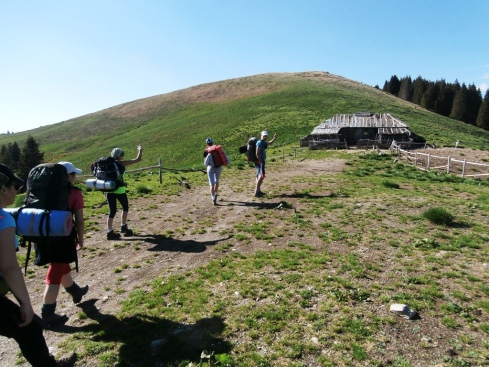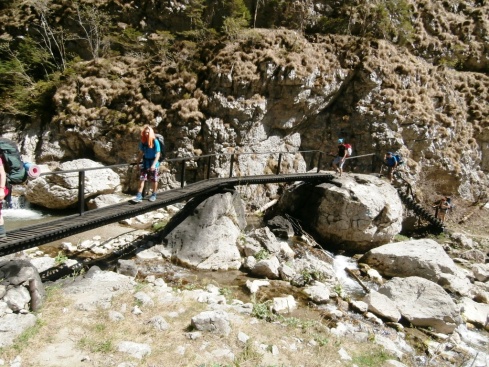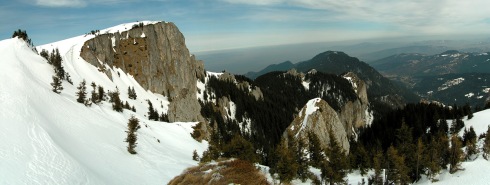
You should know how to choose your clothes properly in order to have a pleasant, cozy hike. Note that at heights above 2000 m (6562 ft) you may witness even three seasons a day, and in some cases the temperature may drop as much as 15-20°C in a few minutes. On the other hand, you may hike on cold weather, but on such an effort as climbing on a mountain trail, you burn a lot of calories which makes your body to heat itself and therefore to sweat a lot. So you may realize how important is for you to know how to choose your equipment. Here is what you should know:
1. You should NEVER choose one thick woolen pullover and one thick jacket, doesn’t 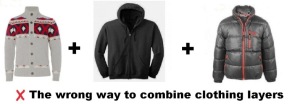 matter how cold the weather. Your clothing must be organized in more thin adjustable layers, rather than a couple of thick layers. Your clothing layers must be as light as possible, to occupy as little space as possible and you have to be able to take it off and put it on fast and easily, according to climate changes.
matter how cold the weather. Your clothing must be organized in more thin adjustable layers, rather than a couple of thick layers. Your clothing layers must be as light as possible, to occupy as little space as possible and you have to be able to take it off and put it on fast and easily, according to climate changes.
2. Your clothing fabrics must be rainproof. If a rain comes unexpected, your clothes have to protect your body against this water. Also, if you hike in the morning  and the grass is saturated with dewdrops, the effect for your boots and trousers is similar. Another situation is if you hike on moist snow (in sunny warm days when the snow melts).
and the grass is saturated with dewdrops, the effect for your boots and trousers is similar. Another situation is if you hike on moist snow (in sunny warm days when the snow melts).
3. Your clothes must be breathable. As I said, when we make great effort we burn a lot of calories which result in a lot of heat and our body sweats a lot. This is the effect of cooling function of human body. The clothes we wear should be able to let the sweat vapour out and if they eventually get wet, to be able to get dry easily. This is why thin layers are preferred.
4. Your clothes must be made of thermoinsulating fabrics( keep the heat in and let the cold out).
So, what you need to keep in mind is that when you go hiking you need to take care of your body comfort. This means 4 things: fast adjustability (easy put on and take off), rainproof, breathability, thermoinsulation.
If we talked about clothing layers disposal, let’s see which these are:
1. Body layer or base layer consists of clothes you wear on skin (T-shirts, underwear, pants, shorts etc.). Best fabrics for T-shirts are polyester and Capilene®, because they don’t retain sweat and they dry fast. New fabrics appear continuously (e.g. Cocona®). For underwear and pants, best fabrics are cotton and polar fleece because they are skin friendly and light. Cotton is not so popular for T-shirts because it retains water and doesn’t dry so fast.
on skin (T-shirts, underwear, pants, shorts etc.). Best fabrics for T-shirts are polyester and Capilene®, because they don’t retain sweat and they dry fast. New fabrics appear continuously (e.g. Cocona®). For underwear and pants, best fabrics are cotton and polar fleece because they are skin friendly and light. Cotton is not so popular for T-shirts because it retains water and doesn’t dry so fast.
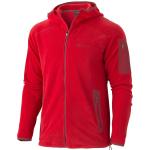 2. Thermoinsulating layer or second layer consists of clothes you wear over the body layer (sweater, parka, trousers) in cold weather with purpose of heating the body. Best fabrics are wool and polar fleece (the last one is preferred because it is lighter and dries faster)
2. Thermoinsulating layer or second layer consists of clothes you wear over the body layer (sweater, parka, trousers) in cold weather with purpose of heating the body. Best fabrics are wool and polar fleece (the last one is preferred because it is lighter and dries faster)
3. The outer layer or outer shell is worn over the second layer. It has the purpose to protect the body against extreme frost, strong wind, snow storm and rain. These clothes are jackets and overtrousers (special trousers with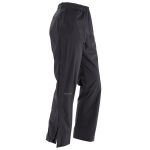 certain features that are worn over usual trousers). They have to be waterproof and breathable. Best fabric with these features is Gore-Tex. This is not actually a textile fabric, but it is a very thin membrane the fabrics are coated with. The usual fabrics that are coated with Gore-Tex are polyester (for gaiters, jackets and trousers) polar fleece (for sweatshirts and trousers), Cordura (for gaiters, boots and lower parts of the trousers) and Nubuck/Suede Leather (for boots).
certain features that are worn over usual trousers). They have to be waterproof and breathable. Best fabric with these features is Gore-Tex. This is not actually a textile fabric, but it is a very thin membrane the fabrics are coated with. The usual fabrics that are coated with Gore-Tex are polyester (for gaiters, jackets and trousers) polar fleece (for sweatshirts and trousers), Cordura (for gaiters, boots and lower parts of the trousers) and Nubuck/Suede Leather (for boots).
Tags: beauty, clothing, clothing fabrics, nature, style, winter

